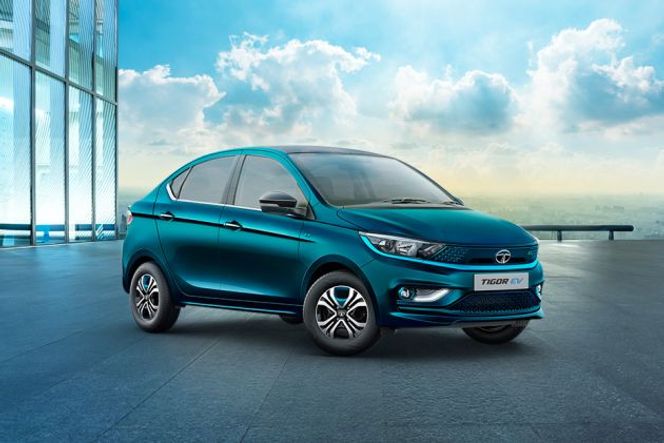 + 34Images
+ 34Images
 + 4Colours
+ 4Colours
Tata Tigor EV 2021-2022
Change carTata Tigor EV 2021-2022 specs & features
| Range | 306 km |
| Power | 73.75 bhp |
| Charging Time DC | 65 Minutes |
| Seating Capacity | 5 |
- Automatic Climate Control
- Parking Sensors
- KeyLess Entry
- Rear Camera
- Voice Commands

iRA Connected Car Technology

7-inch Harman Infotainment touchscreen

Automatic Climate Control is Standard

Signature aqua-colour accents make it instantly recognisable as an EV

The 8-speaker Harman audio system continues to impress

The Z Connect app lets you access car information on the go
- Key Specifications
- Top Features
- Stand Out Features
Tata Tigor EV 2021-2022 price list (Variants)
| Tigor EV 2021-2022 XE(Base Model)306 km, 73.75 bhpDISCONTINUED | Rs.12.49 Lakh* | |
| Tigor EV 2021-2022 XM Plus306 km, 73.75 bhpDISCONTINUED | Rs.12.49 Lakh* | |
| Tigor EV 2021-2022 XM306 km, 73.75 bhpDISCONTINUED | Rs.12.99 Lakh* | |
| Tigor EV 2021-2022 XZ Plus306 km, 73.75 bhpDISCONTINUED | Rs.13.49 Lakh* | |
| Tigor EV 2021-2022 XZ Plus Dual Tone(Top Model)306 km, 73.75 bhpDISCONTINUED | Rs.13.64 Lakh* |
Tata Tigor EV 2021-2022 expert review
overview
Exterior
Interior
Safety
Performance
Verdict
Pros & Cons of Tata Tigor EV 2021-2022
Things We Like
- Affordable and practical EV
- Compact size ideal for city duties
- Claimed range of 306km
Things We Don't Like
- Charging infrastructure is still lacking
- Should have had a sub-Rs 10 Lakh variant
- Spare wheel placed in boot, reducing available space
Tata Tigor EV 2021-2022 Car News & Updates
Tata Tigor EV 2021-2022 latest update
Latest Update: The Tigor EV is getting a feature upgrade and possibly a new top-spec variant. It could get cruise control and regenerative braking from the Tiago EV.
Price: Prices for the Tigor EV range from Rs 12.49 lakh to Rs 13.64 lakh (ex-showroom).
Variants: It is offered in three trims: XE, XM and XZ+.
Battery and Charging: It gets the same Ziptron EV tech present in the Nexon EV. The Tigor EV is equipped with a 26kWh battery pack mated to an electric motor making 75PS and 170Nm. Its battery pack can be refilled from 0-80 per cent in 8.5 hours using a standard wall charger and in 60 minutes using a 25kW DC fast-charger.
Range: Tigor EV has an ARAI-claimed range of 306km.
Features: Features on board the Tigor EV include a seven-inch touchscreen infotainment system with four speakers and an equal number of tweeters, auto AC, height-adjustable driver seat and electrically foldable ORVMs.
Safety: In terms of passenger safety, it gets ABS with EBD, dual front airbags and hill ascent/descent control, rear defogger, rear parking sensors and a rear-view camera.
Rivals: As of now, the Tata Tigor EV has no direct rivals, but it can be considered an affordable alternative to the Nexon EV Prime, Nexon EV Max and the Mahindra XUV400 EV.
Tata Tigor EV 2021-2022 images
Tata Tigor EV 2021-2022 range is 306 km, depending on the variant.
| Motor and Transmission | ARAI Range |
|---|---|
| Electric - Automatic | 306 km |
Questions & answers
A ) No, Tata Tigor EV does not come with cruise control.
A ) The Tata Tigor EV XZ Plus is priced at ₹ 12.99 Lakh (ex-showroom in Guwahati).To...Read More
A ) It would be unfair to give a verdict here as the battery life would depend on ce...Read More
A ) Exchange of Honda Amaze to Tigor EV would depend on certain factors such as kilo...Read More
A ) For CSD availability we would suggest you to exchange words with the CSD staff a...Read More
Trending Tata cars
- Popular
- Upcoming
 Tata TigorRs.6 - 9.40 Lakh*
Tata TigorRs.6 - 9.40 Lakh* Tata CurvvRs.10 - 19 Lakh*
Tata CurvvRs.10 - 19 Lakh* Tata NexonRs.8 - 15.50 Lakh*
Tata NexonRs.8 - 15.50 Lakh* Tata PunchRs.6.13 - 10.15 Lakh*
Tata PunchRs.6.13 - 10.15 Lakh* Tata HarrierRs.14.99 - 25.89 Lakh*
Tata HarrierRs.14.99 - 25.89 Lakh*

-90.jpg?tr=w-664)